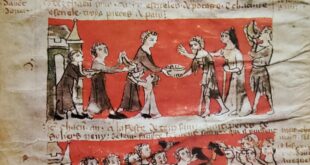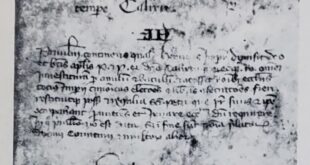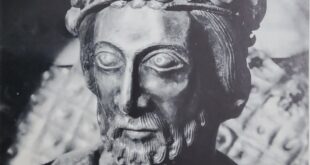Frankish hordes crush the Romans at Soissons and the disintegration of Europe begins.
Japan during the Heian period
For some three and a half centuries after the founding of Kyoto, Japan had an imperial court and administration devoted to a refined culture, that has shaped the character of the people down to this century. Power was in the hands of the Fujiwara family who intermarried with the imperial house and provided “regents” for a line of boy-emperors, most of whom abdicated voluntarily when they reached adulthood. The Emperor became an idealized figure, protected from the corrupting effects of actual political rule. The sensitive, stylish yet formal spirit of the Heian period under the Fujiwara, who enjoyed their greatest ascendancy from the mid-tenth to the mid-eleventh centuries, is fully embodied in the literary masterpiece Genji Monogatari written by a court lady, Murasaki Shikibu, in the early eleventh century.
In sharp contrast to the delicate, almost effete life of the capital, was the life on the great semi-independent estates. The large landowners gradually acquired exemption from taxation; thus developed a feudal system with parallels to that in Europe. As the Fujiwara began to lose their grip on events, civil war broke out between rival factions of the family. In the twelfth century, they called two of the powerful military provincial families to their aid. Not surprisingly, when the smoke cleared after a long period of near anarchy, the Fujiwara found that they had been entirely supplanted by their military advisers. In 1166, the Taira family seized power and for the first time in three centuries, japan witnessed political executions; some twenty years later, the Taira were overthrown by the great Minamoto Yoritomo and in 1185, Japan came under a government controlled by the military. The age of the tea ceremony was succeeded by the age of the samurai: the struggle between the Taira and the Minamoto launched the great period of Japanese chivalry. The principle of military control of the government was to remain at the heart of the Japanese administrative system for another seven centuries.

The Lombards in Italy
Only six years after the founding of Kyoto had marked the beginning of a new epoch in Japan, a still more dramatic turn of events gave new style and pretension to the more backward, if perhaps more vigorous civilization of the West. In terms of territorial power, Charlemagne had just claim to the title of Emperor. In a real sense, he controlled most of Christian Europe and the rise of the Frankish power and the house of Charlemagne himself, will be an important theme in what follows. First though, we must look at events in Italy after the fall of the Ostrogothic kingdom in the sixth century. Like all the barbarian invaders of the later Roman Empire, the Lombards had originated in north Germany. By the middle of the sixth century, they were established in a territory comprising parts of modern Austria and Hungary, where they acted as the allies of Justinian, assisting the imperial armies against another Germanic tribe, the Gepids, who threatened the Danubian frontier. In the late 560s, however, they abandoned their allegiance to the Emperor and crossed into northern Italy, where they established themselves within a generation. The capital of the new Lombard state was at Pavia, in the region still known as Lombardy. To the south, the two powerful Lombard duchies of Benevento and Spoleto maintained their independence of the Byzantine emperors and for a long time, of the Lombard kings of the north as well.
The Three Powers
During the seventh and eighth centuries, Italy was divided among three main powers: the Lombards in the north and central areas; the Roman papacy, at first acknowledging imperial suzerainty, but soon acting with increasing independence; and the Byzantine exarchate at Ravenna, with additional strong Byzantine presence in the southernmost part of the peninsula and in Sicily.

The Lombards were at first a ruling warrior minority, distinguished from their subjects not only by race and language, but also by religion—those who did adopt Christianity chose Arianism. The independence of Spoleto and Benevento is to be explained, not only by their geographical remoteness from the capital, but also by the Lombard social order in which the local leaders, or dukes, enjoyed a considerable authority over their following. Indeed, after the death of Alboin, the leader of the original invasion, Italy was ruled for ten years by thirty-six dukes, but the pressures of Byzantine and Frankish armies compelled a return to kingship. Thereafter, the state became increasingly unified, with a system of royal ministers in the provinces. In the middle of the seventh century, a code of laws written in Latin and reflecting both Lombard and Roman practices, was published. Despite the continuing separateness of the Lombard warrior-aristocracy, the increasing influence of late Roman ideas in art and administration is observable. Most significant of all, was the gradual ousting of Arian Christianity in favour of Catholicism and the intermarriage of the Lombard and Roman populations.
The height of Lombard power and prestige, came during the reign of Liutprand (712-44), who extended the conquests of Byzantine territory still further and asserted northern Lombard authority over the duchies of Benevento and Spoleto. During his reign, the great Lombard historian Paul the Deacon began his famous history, the earliest of a German people by a German writer, which ends with the reign of Liutprand.

Liutprand’s successors, in an attempt to remove the alien corridor between the two halves of the Lombard domain, moved against the lands of the papacy and the remaining territories of the exarchate of Ravenna, but the papacy called in the assistance of its powerful Catholic ‘”sons,” the Frankish kings.
On the first occasion of a papal summons, Pepin the Short compelled the Lombards to abandon their conquests and confirmed the papacy’s possession of these lands. From this so-called Donation of Pepin, may be dated the existence of the papal states as a separate and autonomous territorial unit. Some twenty years later, the Pope called on the aid of Pepin’s son Charlemagne. In 774, after his defeat of the Lombard armies, Charlemagne was himself crowned king of Lombardy with the iron crown. From this time on, the successors of Charlemagne were to claim imperial rights in Italy, which was to lead them into many exhausting and largely fruitless expeditions.

Rise of the Franks
While the sun of imperial Rome in the West was setting over the walls of Ravenna and while the popes at Rome were maintaining themselves as best they could between the Arian heretic king of Italy on the one hand and the claims of the Byzantine Emperor on the other, a new power was rising north of the Alps early in the sixth century. This was the Frankish kingdom of Clovis and his descendants. With his victory at Soissons over Syagrius in 486, when he was only twenty, Clovis had effectively put an end to the last vestige of Roman rule in Gaul. Over the next twenty years, this leader of a once insignificant tribe, overthrew the most powerful barbarian kingdoms, defeating in turn the Thuringians, the Alemanni and above all, the Visigoths at Vouille in 507.
In the long vista of history, perhaps the most important event in Clovis’ reign was his conversion to Catholic Christianity. By this act, he won the support of the indigenous Romano-Gallic population, the support of the Church and the title of consul from the Emperor. In return, Clovis himself protected the Roman Church in Gaul. In the years that followed his death in 511, the Frankish kingdom—although divided among his four sons, continued to expand. The kingdom of the Burgundians, between the Rhone and Loire, was conquered; the duchy of Bavaria acknowledged Frankish suzerainty; and at this early date, we find the Franks making expeditions into Ostrogothic Italy as allies of Justinian.

Charles Martel
In the early seventh century, a new power structure emerged in Gaul, one dominated by the western kingdom of Neustria, the eastern kingdom of Austrasia, the semi-independent kingdom of Burgundy and the duchy of Aquitaine. In the last twenty years of the century, Austrasia and Neustria — although
nominally ruled by descendants of Clovis, the notorious “do-nothing” kings—were united under the effective rule of Pepin of Heristal, the chief minister or ‘mayor of the palace” of the king of Austrasia. He was succeeded by his illegitimate son, the great Charles Martel (the Hammer). Martel was not only the ruler of the two northern Frankish kingdoms, but also received the submission both of Aquitaine and Burgundy.
At this point, the impetus of the second wave of Islamic conquest was by no means spent. Even after the crushing defeat that the Frank- ish army under Martel inflicted on r them at the battle of Poitiers in 732 – the Arabs might still have posed a – severe threat had it not been for their own internal dissensions. In addition to his achievements as a soldier, which included the pacification of a number of Germanic tribes on the right bank of the Rhine, Charles Martel did much to unify the Frankish kingdom, both by eliminating the worst excesses of the nobility and asserting the influence of the state in the affairs of — the Church. In many ways, he laid the foundations for the achievements of his son, Pepin the Short and his grandson, Charlemagne.
Although Charles Martel did not assume the title of king, the fiction of the Merovingian rule was already difficult to support during his rule. Ten years after Martel’s death, Pepin the Short, had his deposition of the last of the Merovingians and his own coronation confirmed by the Pope – in return for helping the Pope against the Lombards in Italy. Half a century later, Pepin’s son was to accept the consecration of the Church for a still greater honour, that of Emperor, on the fateful Christmas Day of the year 800.

























